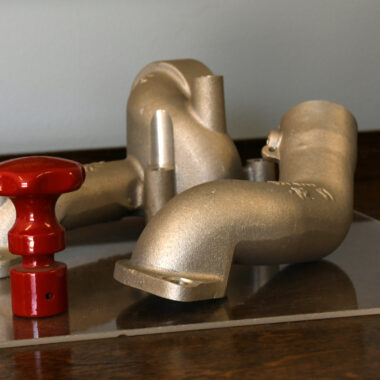Unraveling About Aluminum Casting: From Basics to Proficiency
Unraveling About Aluminum Casting: From Basics to Proficiency
Blog Article
Crafting Perfection: Just How to Attain High-Quality Light Weight Aluminum Castings Every Single Time
In the world of light weight aluminum casting, the quest of excellence is a continuous journey that needs a careful method and an eager understanding of the intricacies included. Attaining consistent top notch aluminum castings demands a detailed understanding of the processes, from selecting the suitable alloy to implementing specific mold designs and carefully managing spreading parameters.
Understanding Aluminum Casting Processes
Aluminum casting processes, vital in the production sector, entail the detailed makeover of liquified light weight aluminum right into strong types via a collection of carefully controlled steps. Comprehending these procedures is extremely important to attaining high-quality aluminum spreadings continually - about aluminum casting. The key approaches made use of in light weight aluminum spreading are pass away spreading, sand spreading, and investment casting

Each of these processes has its benefits and is chosen based upon aspects like complexity, quantity, and wanted coating of the aluminum casting. about aluminum casting. Recognizing the details of these techniques is critical for producers aiming to produce high-quality light weight aluminum spreadings continually
Selecting the Right Aluminum Alloy
Choosing the proper aluminum alloy is a vital choice in the production of high-grade light weight aluminum spreadings. The choice of alloy substantially affects the buildings and characteristics of the last product. Various aluminum alloys offer varying degrees of strength, rust resistance, machinability, and thermal conductivity. When selecting a light weight aluminum alloy for spreading, it is necessary to take into consideration the particular requirements of the application to ensure optimum performance.
One of the most generally used aluminum alloys for casting is A356. This alloy offers superb castability, high toughness, and excellent rust resistance, making it ideal for a wide range of applications. Additionally, 6061 light weight aluminum alloy is favored for its superior weldability and great mechanical homes. For applications calling for high strength, 7075 aluminum alloy is a preferred choice due to its outstanding strength-to-weight proportion.
In enhancement to mechanical buildings, considerations such as cost, schedule, and post-casting processes must also influence the choice of the ideal aluminum alloy. By carefully reviewing these variables, makers can make sure the production of high-grade aluminum spreadings that fulfill the desired specs.
Carrying Out Correct Mold And Mildew Layout
Creating an efficient mold design is essential for ensuring the effective manufacturing of top notch aluminum spreadings. Correct mold design plays a substantial duty in accomplishing the desired features of the end product. To implement an effective mold design, variables such as material circulation, cooling rates, and component geometry should be carefully taken into consideration.
One key facet of mold and mildew design is making certain appropriate filling and solidification of the light weight aluminum within the mold and mildew cavity. This entails creating jogger and gating systems that facilitate smooth steel flow and avoid defects such as air entrapment or incomplete dental filling. Furthermore, incorporating air conditioning networks into the mold and mildew design aids control solidification prices and reduce the danger of porosity or shrinkage flaws.

Controlling Spreading Parameters

Ensuring Post-Casting High Quality Checks
To maintain the top quality of aluminum spreadings, comprehensive post-casting top quality checks are important. After the spreading process is finished, it is crucial to make sure that the final items fulfill the preferred specifications and standards. One of the primary quality checks includes inspecting the surface coating of the spreadings to identify any type of defects such as porosity, fractures, or surface area abnormalities. This visual assessment is often supplemented by non-destructive testing approaches like ultrasonic screening or dye penetrant evaluation to identify internal defects that might endanger the honesty of the spreading.
Dimensional precision is an additional essential aspect that must be verified during post-casting high quality checks. Measurements of essential dimensions and resistances should be taken to validate that the castings satisfy the needed requirements. Furthermore, mechanical homes such as solidity, tensile toughness, and influence resistance might need to be assessed with material testing next page to make sure you can try this out that the castings possess the needed toughness and durability for their intended application.
Verdict
In verdict, attaining top notch aluminum castings needs a detailed understanding of the casting procedures, selecting the ideal alloy, creating molds efficiently, controlling spreading specifications carefully, and conducting post-casting top quality checks vigilantly. By adhering to these actions, manufacturers can consistently generate aluminum spreadings that satisfy the highest criteria of high quality and efficiency.
Accomplishing consistent top quality aluminum castings requires a detailed grasp of the procedures, from selecting the ideal alloy to carrying out precise mold and mildew designs and thoroughly controlling spreading parameters. The main methods utilized in light weight aluminum casting are pass away casting, sand casting, and financial investment casting.
Financial investment spreading, also recognized as precision casting, entails creating wax patterns that are covered in ceramic to create molds.Choosing the suitable light weight aluminum alloy is a crucial decision in the manufacturing of high-quality aluminum spreadings.Ensuring accurate control over spreading criteria is important for keeping consistency and high quality in light weight aluminum spreading production.
Report this page